|
Fantasy Football Strategy, Advice, and Commentary |
|

 By: Dave Stringer — July 7, 2011 @ 10:19 am By: Dave Stringer — July 7, 2011 @ 10:19 am
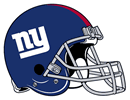
Do you get the feeling that Eli is the Rodney Dangerfield of fantasy quarterbacks? Rodney couldn’t get any respect and neither can Eli. After his breakout campaign in 2005 when he finished as the fourth-ranked fantasy quarterback (albeit in a soft year for production at the position), he fell to 11th, 13th, and 15th over the next three years. However, over the last two seasons, Manning has made it into the top ten, finishing seventh this past season and 10th in 2009. Yet despite his two consecutive 4,000-yard seasons and 58 touchdowns over that period, look for Eli to be rated as a bottom-tier starter in 12-team leagues heading into 2011. “He ain’t heavy, he’s my brother” might best sum up the respect Eli gets in fantasy circles. Clearly Manning’s production is due in part to his solid supporting cast, including one of the league’s best trios of wide receivers in Hakeem Nicks, Steve Smith, and Mario Manningham—along with a solid pass-catching running back in Ahmad Bradshaw and a serviceable tight end in Kevin Boss. Look for the Giants to bring back that same supporting cast on offense, although Smith is a question mark because of the microfracture surgery he needed to repair the knee injury he suffered midway through last season. Considering his propensity for giving the ball away (25 interceptions and five fumbles in 2010), move Manning down in leagues that penalize turnovers, but consider him a decent option just outside the big six at quarterback.
Last year Bradshaw won the training camp battle against incumbent starter Brandon Jacobs and proceeded to have a solid season for the Giants. The former seventh-round pick produced career highs in rushing yards (1,235), receiving yards (314), and touchdowns (8), finishing 13th overall at running back. The only black mark on his season was his six fumbles, which caused head coach Tom Coughlin to relegate him to backup status from Week 12 to 16. The Giants have become more of a passing team over the last two seasons, and that virtually ensures that Bradshaw will remain the starter due to Jacobs’ inability to catch the ball. Bradshaw enters 2011 as a mid-tier RB2 with upside and with a mild amount of risk due to his fumbling issues.
Jacobs enters 2011 coming off a pair of subpar fantasy seasons. He was injured and largely ineffective in 2009 and then lost his starting position to Ahmad Bradshaw last season. Jacobs was a rising fantasy star after posting consecutive 1000-yard seasons in 2007 and 2008 as well as putting up 15 touchdowns in 2008. However, Bradshaw appears to be firmly entrenched as the starter, so the prospect of Jacobs emerging as a fantasy stud appears to be over. While his fantasy stock has taken a hit, he remains a solid RB3 and a great flex option in leagues that employ the position. Despite losing his starting position, he still managed to average 8.9 points per game—a drop of only 0.3 from 2009—with 882 total yards and nine touchdowns. In addition, he has only missed one game over the last two seasons, putting to rest the injury concerns that plagued him earlier in his career. He also raised his yards per carry from 3.7 in 2009 to 5.6 last season. Add it all up and he might provide value on draft day.
After a solid rookie campaign, Nicks entered 2010 on the verge of overtaking Steve Smith as Manning’s go-to receiver. Sure enough, he blasted out of the gates with a four-reception, 75-yard, three-touchdown performance against the Panthers in Week 1. From there, Nicks went on to establish himself as the team’s top receiving threat, having an outstanding sophomore season with 79 receptions for 1,052 yards and 11 touchdowns, despite missing two games with injuries. Entering 2011, Nicks has the potential to become one of the top five receivers in the league due to his impressive combination of size, speed, and route-running ability, although he is still prone to the occasional drop. With Steve Smith likely to suffer a dip in production courtesy of offseason microfracture surgery, look for Nicks to see a big increase from the 128 targets he had in 2010. Because of that, he is a solid bet to finish in the top ten at wide receiver, and a top-five ranking would come as no surprise.
Smith burst onto the scene in 2009, finishing the year with 107 receptions (the most in team history) for 1,220 yards and seven touchdowns. With the Giants moving to more of a pass-based offense, more of the same was expected last season. However, Smith caught the injury bug, suffering a torn pectoral muscle that caused him to miss four games, only to return and suffer a season-ending knee injury in Week 14. Even when he was in the lineup, his production was down, with his point-per-game average slipping from 10.3 to 7.9. With Mario Manningham developing into a big play receiver and Smith’s recovery from microfracture surgery uncertain—and a stint on the PUP to open the season not out of the question—he ranks as a backup wide receiver at best in 2011. And don’t forget that he’s a better option in PPR leagues than in standard scoring formats.
After washing out during his rookie season in 2008, Manningham finished as the 28th-ranked fantasy wide receiver in 2009 and then improved upon that in 2010, finishing 15th. He became better in every area last season, finishing with 60 receptions for 944 yards and a healthy nine touchdowns, which were all career highs. What is even more impressive is that he managed that with only 92 targets while catching 65.2 percent of those targets—a very high percentage considering he finished the year averaging 15.7 yards per reception. With Steve Smith coming off a knee injury and Manningham having shown major improvement over the past two years, he is a breakout candidate in 2011. Look for Manningham to open the season in the starting lineup and relegate Smith to a backup role. There isn’t anything to suggest he can’t finish as a WR2 again in 2011, especially since he should see the ball more. He will likely be a bargain on draft day.
Entering his fifth season in the league, it appears that the mold has been set for Boss’s offensive production. Basically, it’s touchdowns, touchdowns, touchdowns. He doesn’t catch a lot of balls (42 is his career-high), he doesn’t get a lot of yards (a career-high of 567), and he’s wildly inconsistent with 19 games of five fantasy points or fewer in his 30 games over the last two seasons. However, he has 16 touchdowns over the past three seasons and has scored at least five every year. Entering 2011, there may be more opportunities for Boss to produce with Steve Smith recovering from a knee injury. He will need to hold off third-year player Travis Beckum for the starting nod, but that appears likely. Boss is clearly a TE2 with little upside and ranks as a mid-tier backup.
 By: Dave Stringer — July 5, 2011 @ 3:07 pm By: Dave Stringer — July 5, 2011 @ 3:07 pm
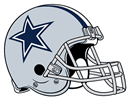
After finishing as a top-five fantasy quarterback in 2009, Romo gave his owners high expectations entering 2010 that were dashed with a broken clavicle that ended his season in Week 6 and also put the team’s playoffs hopes to bed. That’s the bad news. The good news is that Romo was having a solid campaign before he was injured, averaging 21.3 points per game, a very slight decline from the 22.3 points per game he averaged from 2007 through 2009. Although there are questions along the offensive line, the Cowboys figure to return all of their key passing weapons from a year ago and are expecting major improvement from 2009 first-round pick Dez Bryant. Add it all up and Romo is a solid bet to finish with 4,200 yards and close to 30 touchdowns. That should be enough to finish just outside of the big six at quarterback.
The Cowboys’ depth chart at running back has been in flux for much of the offseason, with Jones’ fantasy prospects along for the ride. On the plus side, the Cowboys are very likely to release Marion Barber, who was Jones’ main competition for the starting position. On the down side, the team chose DeMarco Murray in the third round of the draft with the expectation that he will assume Barber’s role in the backfield. While competing with a rookie for touches is preferable to competing with an established veteran, the bottom line is that Murray’s selection is a clear signal that the team does not consider Jones a candidate to assume a big workload, despite the fact that he finished with career highs in rushing yards (800), receiving yards (450), and receptions (48). Murray’s presence will once again make the Cowboys backfield a running-back-by-committee approach, with Tashard Choice also in the mix. Jones is clearly a talented runner who possesses blazing speed, but that hasn’t translated into consistent production. Entering his fourth season, this is likely Jones’ last chance to prove his worth as a starter in Dallas. With Murray on board to steal goal line touches, Jones’ touchdown production (eight through his three years in the league) isn’t likely to rise, and neither is his 26th ranking from last season. There’s basically no reason to expect a breakout campaign from Jones in 2011, and that makes him a RB3 with little upside.
The Cowboys like to employ at least one bruising back, and with Marion Barber suffering a major decline in production last season, the team used a third-round draft pick on Murray. He is a similar player to Barber, but with more speed and less size, making him a better option than veteran Tashard Choice to win the backup role behind Felix Jones. Murray unfortunately had injury issues at Oklahoma, so we’ll have to wait to see how well he handles the pounding at the pro level. But given Jones’ injury history and the Cowboys’ reluctance to give a meaningful opportunity to Choice, Murray has intriguing fantasy potential. At worst, he wins the short-yardage and closer role. At best, he ends up getting significant touches as Jones’ misses time. He is a must-have as a handcuff to Jones and worth grabbing as one of the first backups off the board at running back.
Personally, I like Choice. I’m just not too sure the Cowboys feel the same way. With Felix Jones and Marion Barber in the fold, Choice was clearly the team’s third option at running back. Barber is expected to leave, but the team drafted a replica of him in the third round in DeMarco Murray. Expect Choice to be the fallback option once again in 2011. He has been productive when given an opportunity, as evidenced by his double-digit fantasy points in four of the five games in which he has received 15 or more touches. However, his likely status as the third-string running back in Dallas makes him waiver wire material in all but the deepest leagues.
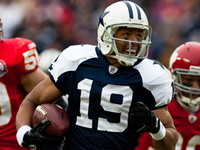 Austin will be happy to see Romo under center in 2011.
After having a breakout season with 1,320 yards and 11 touchdowns in 2009, Austin was a bit of a disappointment last season even though he remained productive. Despite losing Tony Romo at quarterback, Austin still managed to haul in 69 passes for 1,041 yards and seven touchdowns—good enough to finish as the 17th-ranked fantasy wide receiver. However, more was expected from him since he was ranked in the top ten by nearly every fantasy prognosticator. With Romo back in the saddle, Roy Williams clearly an afterthought, and Dez Bryant displaying some offseason difficulties, Austin is in line for another big season in 2011. In the five full games Romo played, Austin had three games of double-digit targets and fantasy points (averaging 12.1) with more than 100 receiving yards in each of those games. For 2011, he shapes up as a high-end WR2 with upside and the possibility of replicating his top-five fantasy ranking from 2009.
The talent is there. The opportunity is there. But is Bryant’s production going to get there, too? Tough question. The Cowboys gambled on Bryant, using the 24th pick in the 2010 draft on a player who likely had top-five talent. As a rookie last season, he displayed his big-play ability both in the passing game and as a returner, finishing the year with 45 receptions for 561 yards and six touchdowns plus a pair of punt return touchdowns, all despite missing four games with a broken leg. However, many of his targets were on screens and short passes, which created the lingering suspicion that he failed to grasp the playbook. That potential issue, made worse by a shortened offseason (as well as his offseason problems and the petulance he displayed at times as a rookie) increase his risk and make the odds of his having a breakout season in 2011 somewhat remote. That being said, he is a gifted player capable of being one of the top five wide receivers in the league. Just don’t bank on that happening this season. Look for Bryant to be a WR3 in 2011, but a player with significant upside.
Has a wide receiver with more talent ever accomplished less than Roy Williams? It is hard to think of one. The light has never fully gone on for the big, fast and reasonably shifty Williams, who has topped 1,000 receiving yards just once in his seven seasons in the league. And he hasn’t gone over 600 yards in any of the past three seasons, although his fantasy production has been padded by the 14 touchdowns he has scored over that span. Williams will turn 30 during the 2011 season, and while that isn’t a huge issue for many receivers, it’s just another reason to avoid this major disappointment.
Entering 2010, Witten’s fantasy reputation was as a player who gained significant yardage year in and year out but who failed to find the end zone on a regular basis, with just six touchdowns combined over the 2008 and 2009 seasons. He put that to rest last season, scoring a career-high nine touchdowns to go along with 94 receptions (for the second year in a row) and 1,002 yards, good enough to make him the top-ranked fantasy tight end. For 2011, the only red flag on Witten is that he caught just two of his nine touchdowns during the six games that Tony Romo started. Ignore that, however, since Witten has topped 90 receptions and 1,000 yards in three of the last four seasons, chalking up 81 receptions for 952 yards in a “down” year in 2008. He’s money and ranks behind only Antonio Gates for 2011.
 By: Dave Stringer — July 1, 2011 @ 1:58 pm By: Dave Stringer — July 1, 2011 @ 1:58 pm
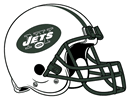
Sanchez has had an interesting two-year run as the Jets’ starting quarterback. Since being taken with the fifth pick in the 2009 draft, he has led the jets to the AFC Championship Game twice, losing both times. Despite that success, he hasn’t received the acclaim one would expect from such a successful start to his career. On the fantasy side, Sanchez improved from the 23rd-ranked quarterback in 2009 to 18th last season, a tidy five-place jump. Nonetheless, that’s still backup status, and there isn’t a lot of evidence to suggest that another significant jump is in the cards for 2011. The Jets are a run-first team that features a quality group of receivers and a good pass-catching tight end in Dustin Keller. The offensive philosophy is based on taking few risks and not turning the ball over. While Sanchez improved his yardage total from 2,444 to 3,291 and his passing touchdowns from 13 to 17, his outlook for 2011 remains that of a fantasy backup.
With Thomas Jones out of the picture and LaDainian Tomlinson expected to assume the role of a third-down specialist and change-of-pace back, much was expected of Greene last year. And he flopped. Big time. Greene was drafted in some leagues as a low-end RB1 with upside, but he finished as the 37th-ranked running back in leagues with standard scoring. Removing running backs who can’t blame their poor production on injuries, Greene was likely the biggest fantasy bust at the position in 2010. But 2011 is a new year and a time for redemption. Tomlinson is a year older and Joe McKnight was so bad as a rookie last year that the Jets drafted Bilal Powell in the fourth round to challenge him. Greene figures to take over as the starter—if not on opening day, then sometime in 2011—and there is a strong possibility he will have a solid fantasy season. The team’s offensive line remains perhaps the best run-blocking unit in the league, and the offensive philosophy will be based heavily on the run. If Greene opens the season as the team’s starter, he figures to be a low-end RB1. If not, draft him as a RB2, but one with considerable upside if he can win the starting job by mid-season.
Well, I told you last year “those of you out there looking for a return to glory for LT in New York, you can think again.” And this year, I’m telling those of you out there expecting a repeat of last year’s return to glory, you can think again. LT was great last season, having a renaissance year with 914 rushing yards, a healthy 4.2 yards per carry, 52 receptions for 355 yards, and six total touchdowns. That placed him as the 18th-ranked fantasy back and provided excellent value to his owners, most of whom grabbed him with a low-round draft pick. That’s the good news. The bad news is that it was a tale of two seasons for LT as he basically hit a brick wall late in the year. He scored just one touchdown in his final nine games and averaged a measly 6.7 points per game in his last five games. From Week 6 on, he averaged only 3.3 yards per carry. At 31, LT is headed for backup status; but in a Jets offense that loves to run, he ranks as an upper-tier backup in 12- and 14-team leagues as well as a nice option in flex leagues.
After his 2007 breakout season in Cleveland in which he caught 80 passes for 1,289 yards and 16 touchdowns, Edwards struggled mightily over the next two years, catching just 90 passes for 1,557 yards and seven touchdowns. Despite showing inconsistent hands at times, he had a bit of a renaissance in 2010, becoming a big-play threat for the Jets while making 53 receptions for 904 yards and seven touchdowns. Fantasy-wise, Edwards’ production dropped when Santonio Holmes returned from a four-game suspension. With Holmes in the lineup, Edwards’ fantasy points per game dropped from 10.2 to 7.6. In New York, Edwards won’t be the featured receiver, with a large part of his role being that of a deep threat. That makes him a WR3 at best in 2011.
There’s not much to dislike about Holmes’ game. He has reliable hands and the speed to get deep. He can turn slants and crossing patterns into big plays. While he has never had a true breakout season, topping 1,000 yards only once in five years and never catching more than eight touchdown passes in a single season, the issue has usually been lack of opportunity, not talent. In Pittsburgh, he mostly played second fiddle to Hines Ward. Last season in New York, he missed the first four games of the season because of a suspension and then he was saddled with playing in a run-based offense that topped 200 passing yards in just six of the 12 games in which he played. Because he’ll be available for all 16 games and have another year in the Jets’ offensive system under his belt, Holmes figures to up his production in 2011. However, another sub-1000-yard season and five or six touchdowns seems most likely. That makes him a high-end WR3 in most leagues.
With Santonio Holmes and Braylon Edwards in the fold, Cotchery will be relegated to the role of fill-in starter and to playing on obvious passing downs, meaning his days as a fantasy starter are clearly over. In fact, Cotchery didn’t even perform well when given an opportunity in 2010, catching just 47.7% of his targets—by far the worst performance in that category in his career. For further evidence of his demise, look to how his yardage totals have dropped in each of the last three years to just 433 last season. Summing it up, he’s a player on the decline playing as a backup in an offense that prefers to run. You can do better.
Over the last two years, Keller has been a reliable, albeit unspectacular, tight end for the Jets, which is somewhat of a disappointment after his impressive rookie campaign in 2008. He is coming off of a career year in 2010 when he finished the season with 55 receptions for 687yards and five touchdowns. Looks good until you dig a little deeper. First off, he caught just 54.5% of his targets, and this percentage has dropped over each of the past two seasons. Secondly, 55 of his 98 fantasy points and all five of his touchdowns came in the first four weeks of the season. Over the remaining 12 games of the year, he averaged a paltry 3.6 points per game. And that’s because once Santonio Holmes returned from a four-game suspension, Keller’s role in the Jets offense was reduced. With Holmes on board for 2012, look for Keller to produce as a TE2.
 By: Mike Krueger — @ 11:22 am By: Mike Krueger — @ 11:22 am
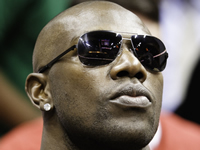 The T.O. Show is in it's final act. I asked our resident athletic trainer, Bob Thompson, to give his analysis of T.O.’s mysterious ACL injury…
Injury: ACL tear and reconstruction
Healing Time: 6 months
Impact on the Field: More drama for this guy. Apparently T.O. injured his knee during a workout back in April. I have read a great deal on his injury because nothing seems to add up to me. Based on what his agent, Drew Rosenhaus, has said, T.O. injured his knee in April, had surgery for a torn ACL, and will be ready by the start of camp, if there is one. The problem that I have is that the time frame doesn’t add up. If T.O. did have surgery in late April, he would not be ready for full contact until October. And that is the best-case scenario. Ask Wes Welker, Owen Daniels, or anyone else with this injury how it works out when they come back to competition within the same calendar year. When a player tears his ACL, he may have little difficulty in performing everyday activities, but he will experience significant problems when placed in an athletic event. T.O. was seen walking around at an event in late April without any noticeable problem. That makes me believe he had surgery sometime in late April or early June and that Rosenhaus is talking him up as ready for camp because he is unsigned. If he takes the field earlier than he should, he will be nowhere as good as he once was. He was already losing speed, and if he loses any more ability, he would become a possession receiver—if he is willing to run those short routes over the middle. As has been reported, he was never a big fan of those routes and I doubt he starts becoming one now.
With all respect to Drew Rosenhaus, I’d be shocked if Owens makes any kind of impact on the field in August or anytime this season. Sure he’s known for being a freakishly quick healer but at this point in his career, who’s going to sign him? He’s already worn out his welcome in San Francisco, Philadelphia, Dallas, Buffalo and Cincinnati. I’m sure Mr. Rosenhaus will do his job and land Owens a roster spot late in the season but make no mistake, the T.O. Show is in it’s final act.
 By: Dave Stringer — June 30, 2011 @ 2:06 pm By: Dave Stringer — June 30, 2011 @ 2:06 pm
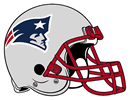 Outside of his magical 2007 season when he threw for nearly 5,000 yards and 50 touchdowns, Brady was never better than he was in 2010. Despite losing the team’s projected top receiver and only true deep threat, Randy Moss, in an early-season trade and being left with a group of merely average receivers, Brady threw for 3,900 yards and 36 touchdowns with a career-low four interceptions. He easily adapted to Moss’ departure, with the offense moving from an air-it-out to more of a dink-and-dunk approach. Considering what he accomplished last year with a lackluster receiving corps, Brady is essentially a guarantee to produce at quarterback. With talented tight ends Rob Gronkowski and Aaron Hernandez entering their second seasons and with the team hopeful that either Brandon Tate or Taylor Price can scare defenses a little on the outside, Brady should at least match his strong season from a year ago. Outside of his magical 2007 season when he threw for nearly 5,000 yards and 50 touchdowns, Brady was never better than he was in 2010. Despite losing the team’s projected top receiver and only true deep threat, Randy Moss, in an early-season trade and being left with a group of merely average receivers, Brady threw for 3,900 yards and 36 touchdowns with a career-low four interceptions. He easily adapted to Moss’ departure, with the offense moving from an air-it-out to more of a dink-and-dunk approach. Considering what he accomplished last year with a lackluster receiving corps, Brady is essentially a guarantee to produce at quarterback. With talented tight ends Rob Gronkowski and Aaron Hernandez entering their second seasons and with the team hopeful that either Brandon Tate or Taylor Price can scare defenses a little on the outside, Brady should at least match his strong season from a year ago.
BJGE came out of nowhere to have a breakout season in 2010. The former undrafted free agent had 1,008 rushing yards, becoming the team’s first 1000-yard running back since Corey Dillon in 2004. He proved to be an effective closer and short-yardage back with his 13 touchdowns, helping him to a 15th place fantasy ranking at running back. And what was his reward for such a respectable season? Watching the team draft running backs in the second and third rounds of this year’s rookie draft. Of those rookies, Stevan Ridley is Green-Ellis’ main threat, given his size and potential as a short-yardage runner. Green-Ellis is certainly not the most talented back in the league, but he figures to earn the most playing time given his strong season, his ability to hold on to the ball (no fumbles in the regular season), and his pass-blocking ability. The team’s coaching staff isn’t going to give much playing time to the rookies until they have proven they can protect their marquee quarterback. There are clearly doubts about BJGE’s fantasy stock in 2011, but he is worth gambling on as a low-end RB2 or upper-tier backup.
If there’s one thing the Patriots have proven over the years, it’s that they can take other teams’ castoffs and make them productive players if they fit the New England system. There were plenty of heads shaking in New York when the Patriots turned former Jets running back Danny Woodhead into a serious backfield threat for much of 2010. Woodhead arrived in New England in time for opening day and took over for Kevin Faulk as the pass-catching and change-of-pace back in Week 3. Generously listed at 5’8” and 195 pounds, Woodhead ran for 547 yards and five touchdowns on just 97 carries while chipping in 34 receptions for 379 yards and another score. You would figure healthy averages of 5.6 yards per carry and 11.1 yards per reception would earn you significant playing time the following season, but Woodhead will battle with the Patriots’ second-round pick, Shane Vereen, for playing time. It’s unlikely Vereen will win the job by opening day, which means Woodhead will have an opportunity to solidify his position on the roster. Expect more of the same from Woodhead in 2010 and draft him as a high-end RB4 who should prove useful as a flex player.
The Patriots were clearly looking for quality competition for Green-Ellis and Woodhead when they took Vereen in the second round and Stevan Ridley in the third. In his rookie year, Vereen shapes up as a competitor to Woodhead as a pass-catching, change-of-pace back; but he’s an intriguing option in dynasty leagues given his overall skill set. A tad undersized at 5’10” and 210 pounds, Vereen could emerge as the Patriots’ lead back in the next year or two. He is unlikely to win extensive playing time by opening day, but he could gain touches as the season goes on. Keep your eye on him in training camp, but at this point he is most likely to be waiver wire material early in the season. In dynasty leagues, he is definitely worth grabbing, given the strong state of the Patriots offense.
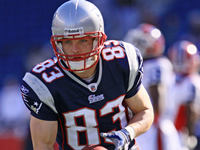 Welker scored double-digit fantasy points in only 5 games last season.
Entering 2011, Welker has a laundry list of both positive and negative issues that affect his fantasy prognosis. On the plus side, he is now a year and a half removed from the surgery that ended his 2009 season, he is clearly the Patriots top wide receiver, and he was a significant weapon in 2010 with 86 receptions for 848 yards and seven touchdowns, which were the second most of his career. The flip side is that he caught 69.9 percent of his targets (down from 75.9 percent for the 2007-2009 period), his reception total was down 30 from his average over the previous three seasons, his yards per reception was the lowest of his career, and he had only five games with double-digit fantasy points. Welker turned 30 in the offseason, and while that usually isn’t a big issue for receivers, it could be for a small player who relies on his quickness and cutting ability to get open. The question is whether his drop in production was mainly the result of his knee injury or whether it was because defenses gave him additional attention with Randy Moss no longer in the lineup. With no proven deep threat on the roster, Welker figures to get plenty of attention again in 2011, so expecting him to bounce back to his 2007-2009 production is not very realistic. Draft Welker as a low-end WR2. He no longer has the upside to achieve WR1 status.
Quick—who is the New England wide receiver to own in 2011? Wes Welker, right? Not so fast. While Welker may bounce back from a bit of a down year, Branch was surprisingly solid for the Patriots after he was acquired from the Seahawks prior to Week 6 last season. In the 11 games in which Welker and Branch were both in the lineup, Branch had 101 fantasy points to Welker’s 87. However, Branch was definitely the more inconsistent of the two players, with less than five fantasy points in the 11 games he played with the Patriots. He will open the season starting opposite Welker, and he figures to roughly duplicate his 2010 production of 61 receptions for 818 yards and six touchdowns. That makes him a low-end WR3, but he will be drafted far lower than Welker in 2011 and should therefore provide excellent value. If you’re looking to get a piece of the New England offense on the cheap, Branch might be your guy.
The Patriots have been waiting patiently for Tate to produce after taking him in the third round of the 2009 draft. So far, they have little to show for their investment. Tate has been a good kick returner, displaying nice moves and the speed that saw him move up draft boards in 2009. However, he has been inconsistent as a receiver and was only marginally useful in 2010 with 24 receptions for 432 yards and three touchdowns. He enters his third year in the league this season, but there is little reason to think he is ready for a breakout year. With a pair of veteran wide receivers ahead of him on the depth chart, two heavily targeted tight ends, and a pair of pass-catching running backs, Tate doesn’t figure to get much more than the occasional deep target in 2010.
Hernandez was a revelation as a rookie early in 2010, busting out of the gate with 34 receptions for 406 yards and a pair of touchdowns over his first eight games. However, a suspected hip injury that caused him to miss the final two games of the season may have caused his second-half stumble, as he caught just 11 passes for 145 yards over the final part of the season—although his four touchdowns over that stretch made his fantasy point total respectable. Fellow rookie Rob Gronkowski emerged as quarterback Tom Brady’s favored option at tight end, but Hernandez has more upside given his ability to stretch the field. Look for Hernandez to win the receiving yardage battle but for Gronkowski to catch more touchdowns in 2011. Draft Hernandez as a mid-tier starting tight end with upside, but as one with an injury risk due to offseason hip surgery.
Gronkowski started slowly in his rookie season in 2010, with just two multi-reception games over the first seven weeks. From that point on, he gained the trust of the coaching staff and earned a greater role in the offensive game plan because of his soft hands and ability to get open on short and intermediate routes. By season’s end, Gronkowski had emerged as a top-ten fantasy producer at tight end, finishing with 42 receptions for 546 yards and a whopping ten touchdowns. Replicating his touchdown count in 2011 seems unlikely if fellow second-year player Aaron Hernandez remains healthy, so Gronkowski enters 2011 as an upper-tier TE2 with upside if he can relegate Hernandez to more of a third-down role.
 By: Dave Stringer — June 29, 2011 @ 1:35 am By: Dave Stringer — June 29, 2011 @ 1:35 am
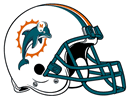 Henne’s fantasy stock was on the rise entering 2010 after the Dolphins traded for Broncos wide receiver Brandon Marshall. The acquisition of Marshall provided Henne with a true number one wide receiver for the first time. With another year under his belt, a solid running game, and Marshall opening up defenses, Henne seemed like a sound bet to have a productive season under center for Miami. Unfortunately for Henne’s owners, he failed to take advantage of the situation and had a disappointing season, throwing for just 3,301 yards with 15 touchdowns and 19 interceptions. He enters 2011 knowing it is a pivotal year in his career. The 2008 second-round pick’s contract is up after the season and he knows this will be his last chance to solidify the starting position in Miami. While he will be motivated, we don’t like his chances of having a breakout season. Henne’s prospects of developing into a fantasy starter are slim, and he fits in as a low-end fantasy backup with little upside. Henne’s fantasy stock was on the rise entering 2010 after the Dolphins traded for Broncos wide receiver Brandon Marshall. The acquisition of Marshall provided Henne with a true number one wide receiver for the first time. With another year under his belt, a solid running game, and Marshall opening up defenses, Henne seemed like a sound bet to have a productive season under center for Miami. Unfortunately for Henne’s owners, he failed to take advantage of the situation and had a disappointing season, throwing for just 3,301 yards with 15 touchdowns and 19 interceptions. He enters 2011 knowing it is a pivotal year in his career. The 2008 second-round pick’s contract is up after the season and he knows this will be his last chance to solidify the starting position in Miami. While he will be motivated, we don’t like his chances of having a breakout season. Henne’s prospects of developing into a fantasy starter are slim, and he fits in as a low-end fantasy backup with little upside.
With the aging duo of Ronnie Brown and Ricky Williams having substandard seasons in 2010 and sitting on expiring contracts, the Dolphins traded up to take Kansas State’s Daniel Thomas in the second round, dealing three of their draft picks to get him. The bruising 6’0”, 230-pound runner enters a great situation in Miami and figures to have the inside track on opening the season as the starter. He was highly productive running the ball at Kansas State and he can contribute in the passing game as well. Given his opportunity, Thomas is in a virtual dead heat with the Saints’ Mark Ingram to be the top rookie running back taken in redraft formats, and he likely ranks behind only Ingram in dynasty rookie drafts. He enters the season as a low-end RB2 or high-end RB3 with upside.
With his trade to the Dolphins prior to the 2010 season, Marshall brought considerable talent to the passing game in Miami. Unfortunately, he also brought a considerable amount of baggage—and he has proceeded to add to it. The Dolphins knew in advance how that equation works, but Marshall, while having a solid year by most standards, had his worst season since his breakout campaign in 2007. After totaling 307 receptions for 3,710 yards and 23 touchdowns during his final three years in Denver, his production plummeted to 86 receptions for 1,014 yards and a measly three touchdowns in Miami. The low touchdown total caused him to drop to 27th in the wide receiver rankings after finishing no worse than 11th over the previous three seasons. Worse yet, he pouted both on and off the field about his role, despite having just eight fewer targets (in one fewer game played) in 2010 than in 2009. Marshall is a big name who will be drafted as a WR1, but there are better options out there that carry far less risk (considering Marshall’s attitude and his quarterback). Buyer beware.
He’s not that big, not that fast, and not exactly the shiftiest receiver in the league. No matter, all Bess does is get open and move the chains, earning the trust of the Dolphins coaches and, more importantly for his fantasy owners, plenty of targets. He has improved his numbers in each of his three years in the league and enjoyed a career year in 2010 with 79 receptions for 820 yards and five touchdowns, all career highs. Considering his penchant for plenty of receptions but not many big plays, Bess is a player whose ranking depends on your league’s scoring system. In redraft formats, he is clearly a WR4 or low-end starter. In point per receptions leagues, he is a solid WR3. Given his lack of star power and the dearth of big plays he provides, he should be a bargain on draft day.
Hartline emerged as the Dolphins’ starting wide receiver opposite Brandon Marshall last year but failed to capitalize on the opportunity. Despite having the talented Marshall opposite him and seeing his targets increase from 56 to 73, Hartline registered minimal improvements in receptions (31 to 43) and receiving yards (506 to 615) while suffering a drop in touchdowns (three to one). Although the 2009 fourth-round pick is entering his third season, a breakout seems highly unlikely given his marginal skill set. On a Dolphins team that would prefer to feature the run more than they did in 2010, Hartline is the third option in the passing game behind Marshall and slot receiver Davone Bess. In fact, it wouldn’t be a surprise if 2011 fourth-round pick Edmond Gates emerges as the starter by midseason.
Fasano enters 2011 coming off of career highs in both receptions (39) and receiving yards (528). Still, his best fantasy season came in 2007 when he padded his fantasy point total with seven touchdowns. Entering his sixth season in the league, Fasano isn’t a player who is about to emerge as a solid pass-catching tight end, nor is he likely to catch a pile of touchdowns with Brandon Marshall in the lineup. He’s a low-end TE2 with little potential. Better to take a flier on a younger tight end who has some upside.
 By: Dave Stringer — June 27, 2011 @ 12:28 pm By: Dave Stringer — June 27, 2011 @ 12:28 pm
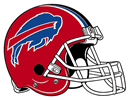
When the Bills pulled the chute on the Trent Edwards era after two games last season, they handed the reins over to the unheralded Fitzpatrick. Prior to 2010, Fitzpatrick had little success filling in for an injured Carson Palmer in Cincinnati in 2008 and for Edwards in 2009. However, the Bills’ moribund passing attack came alive with Fitzpatrick under center for 13 games (he sat out Week 17), and he finished the year with career highs in passing yards (3,000) and touchdowns (23). He is also an underrated threat rushing the ball, finishing the year with 269 yards on the ground (he had 304 in 2008). He also finished as the 17th-rated quarterback but was ninth overall in quarterbacks with ten or more starts. Bills management showed their faith in him by not using a pick in the draft to acquire a young talent at the position, which means he will be the team’s starter in 2011, barring injury. Consider Fitzpatrick an upper-tier backup in 2011 and a player you can feel reasonably comfortable using as your starter if you want to employ the strategy of using a late pick (or few auction dollars) on the position.
If you’re looking for resiliency and determination, look no further than Fred Jackson. Hardly the biggest or fastest running back in the league, he has overcome his status as a Division II college player to unseat a pair of first-round draft picks (first Marshawn Lynch, then C.J. Spiller last year) to retain his starting position with the Bills. And why not? All he does is produce. Despite breaking his hand in training camp and sacrificing playing time as the team showcased Lynch for a trade, Jackson had another productive season. He finished with 927 rushing yards, 215 receiving yards, and seven touchdowns, despite having just 22 touches over the first four weeks of the season. Over the remaining 12 games, he averaged 11.8 fantasy points per game, which ranks as mid-tier RB2 production. Jackson will have to fend off Spiller once again in 2011, but history suggests he will enter the season as the team’s starter. While it’s possible Spiller will take over as the starter at some point, Jackson would still get plenty of touches in that scenario as well as remain the team’s option at the goal line. He should be a good value on draft day.
The Bills took plenty of heat for using the ninth pick in the 2010 draft to take Spiller, despite having Fred Jackson and Marshawn Lynch in their backfield depth chart. The hope was that Spiller would provide a spark as a triple threat—a runner, receiver, and return man similar to Percy Harvin and Reggie Bush. Unfortunately, he didn’t prove to be much of a threat in any facet. He averaged just 3.8 per carry and 6.5 yards per reception, finishing the year with 440 yards and just a single touchdown (although he also had a kickoff return touchdown). Heading into 2011, it’s basically a leap of faith to believe that Spiller is ready to unseat the reliable Fred Jackson as the team’s starter. Spiller will definitely get more touches than he did last season, but he needs to develop into more of a playmaker to become a useful fantasy option. He could become a solid flex option, but it’s hard to predict much more than that from him based on his performance last season.
The Bills signed Evans to a monster four-year, $37.5-million contract early in 2008 and he has done nothing but disappoint since. Over the last two seasons, he has posted successive career lows in receiving yards (612 in 2009 and then 578 last year) and been a complete non-factor on short and intermediate routes. That basically makes him a one-trick pony. But he hasn’t even been able to beat defenders deep, particularly last season when he finished with just four touchdowns. Simply put, he can’t get open anymore, catching just 46.3 percent of his targets in 2009 and 44.6 percent in 2010. Evans lost his role as the Bills lead receiver last year to Steve Johnson, and there’s no evidence to suggest he’s going to earn it back. The Bills are a young, rebuilding team, and the argument could even be made that the 30-year-old Evans will have a lesser role in 2011 as the team attempts to develop a crop of promising young receivers. Let somebody else take a flier on him.
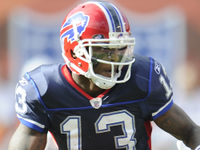 Johnson will retain his role as the top receiver in the Bills offense.
While it certainly wasn’t a surprise when Johnson beat out disappointing 2008 second-round pick James Hardy for a starting position, nobody could have foreseen the tremendous season he would have in 2010. As Lee Evans continued to disappoint, Johnson made the most of his opportunity, finishing the year with 82 receptions for 1,083 yards and 10 touchdowns. That production made him the tenth-ranked fantasy wide receiver last season. While there were plenty of receivers trumpeted as potential breakout candidates entering their third seasons, Johnson was rarely mentioned in that group. Entering his fourth year in the league, and with Fitzpatrick back at the quarterback, Johnson figures to retain his spot as the team’s top receiver and should provide solid fantasy production in 2011. While it’s hard to predict a repeat top-ten performance given his lofty touchdown total last season, Johnson shapes up as a potential upper-tier WR2—one who could be a bargain on draft day given his short track record. Other owners in your league might consider him a one-year wonder. Don’t make that mistake yourself on draft day.
The Bills have been searching for a pass-receiving threat at tight end for what seems like ages. They grabbed Nelson in the fifth round of the 2009 draft hoping he could grow into that role. But he has done little during his first two years in the league, missing much of last season with migraine headaches and having to serve a four-game suspension for violating the league’s substance abuse policy. Nelson is talented and the Bills have little invested at the position, so he remains the player most likely to win the starting job on opening day. Just don’t expect him to make much of the opportunity.
 By: Dave Stringer — February 4, 2011 @ 2:16 pm By: Dave Stringer — February 4, 2011 @ 2:16 pm
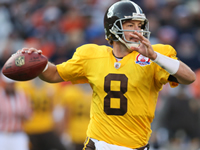 Is Orton really competing for the starting QB job? 1. Recently installed as the Broncos’ executive vice president of football operations, John Elway stated this week that the team would enter training camp with an open competition at the quarterback position. However, the odds are long that 2010 first round pick Tim Tebow will not be starting on opening day. By going public that there would be a competition at the position, Elway accomplished two goals. First, he keeps the heat on Tebow and reinforces that he will need to work hard during the offseason to win the starting position. Secondly, he signals to other teams potentially interested in Kyle Orton that Orton is in the team’s plans and won’t be released by the club. Therefore, any team looking at Orton as a potential starter in 2011 will need to acquire him via trade from the Broncos. Denver has taken some heat for giving Elway such a prominent role despite his inexperience but the early indications are that he is a quick study and that bodes well for Broncos fans.
2. The Falcons signed head coach Mike Smith to a three-year contract extension this week, locking up him through the 2014 season. Smith led the Falcons to the top seed in the NFC this season and the Falcons have had a winning record in each of his three years in Atlanta, going 33-15 over those seasons. The team compiled back-to-back winning seasons for the first time in the franchise’s history under Smith’s tenure and with this extension, the AFC South will boast arguably the top group of division coaches in the league over the next few years. Sean Payton led the Saints to the Super Bowl championship last season while the Buccaneers Raheem Morris finished second in the AP Coach of the Year voting this season. In Carolina, the Panthers have brought in Ron Rivera and he has been a successful defensive coordinator for several seasons. The AFC South had two playoff participants this year and it won’t be a surprise if that remains the case for the next couple of seasons.
3. Sticking with the Falcons, general manager Thomas Dimitroff faces some interesting offseason decisions regarding the team’s stable of running backs. While Michael Turner is clearly the team’s most talented back and is signed long term, both of the team’s top backups are likely to be unrestricted free agents once a new collective bargaining agreement is signed. Jason Snelling took over as Turner’s top backup during 2009 and held that role this past season. Jerious Norwood has struggled with injuries over the past two seasons, playing in just 12 games, but remains an explosive player when healthy and can also contribute as a returner. With Snelling having proven to be a productive receiver out of the backfield (a role that Turner has never embraced) with 74 receptions over the last two years, there is less of a need for the Falcons to bring Norwood back. However, the Falcons rely heavily on the ground game and Norwood’s leverage is significantly hampered due to his inability to stay healthy so there is a strong chance he will be back in Atlanta in 2011.
4. Over in Carolina, the Panthers surely felt the sting when Stanford quarterback Andrew Luck chose to forego turning pro, leaving 2010 draft picks Jimmy Clausen and Tony Pike as the only players at the position likely to return to the team for the 2011 season. While Panthers general manager Marty Hurney went public with the team’s plans to upgrade the quarterback position, don’t be surprised if Clausen ends up starting on opening day next season. With a defensive minded head coach in Ron Rivera, a stable of talented running backs and an offensive line built for run blocking, the Panthers will likely employ a short passing attack which suits a young quarterback like Clausen. With none of this year’s crop of rookie quarterbacks being worthy of being the top overall selection in the draft and this year’s crop of veteran free agents on the downside of their careers, the odds are strong that Clausen will emerge as the Panthers starter in 2011.
5. In Cincinnati, the Bengals took their time in deciding the fate of offensive coordinator Bob Bratkowski, finally choosing to fire him this week. Bratkowski successfully used a heavily run-based offense in 2009 with the team winning the AFC North title that season. However, with the addition of Terrell Owens, Bratkowski abandoned the running game with decidedly mixed results. Jay Gruden, Jon’s brother, will take over for Bratkowski next season and he inherits an offense with a number of pressing issues. Quarterback Carson Palmer has asked to be traded, running back Cedric Benson is a free agent and wants a commitment to the running game before re-signing, Owens won’t be back and Chad OchoCinco may be on his way out as well, leaving a largely unproven trio of wide receivers in Andre Caldwell, Jerome Simpson and Jordan Shipley. This will be Gruden’s first season as an offensive coordinator in the league and that factor combined with the uncertainties at several skill positions could turn the Bengals offense into a fantasy mess in 2011.
6. The Chiefs were in the market for an offensive coordinator after Charlie Weis chose to leave Kansas City for the comfy confines of the coordinators role with the Florida Gators. Rather than bring in a big name for the position, they chose to promote offensive line coach Bill Muir. Muir’s promotion removes any doubt that head coach Todd Haley will be the main driving force and play caller for the Chiefs offense in 2011. The decision to hire Muir doesn’t come as a surprise as there were several rumours during the season that Haley clashed with Weis over the team’s offensive direction. Haley’s strong personality may have scared away potential candidates but the more likely scenario is that he wanted the added responsibilities and an offensive coordinator who isn’t likely to clash with him on game day.
7. Super Bowl Fact: For the first time in its 45-year history, the Super Bowl will be without cheerleaders. The Steelers and Packers franchises do not employ cheerleaders so this Sunday’s game will be the first Super Bowl without them. And frankly speaking, if you miss them, you’re missing the point.
8. Super Bowl Prediction: Packers 24, Steelers 20.
9. Hall of Fame Prediction: Marshall Faulk, Deion Sanders, Curtis Martin, Dermontti Dawson, Andre Reed.
« Newer Posts — Older Posts »
| |
|
Powered by
WordPress |
|

|
 QB Eli Manning
QB Eli Manning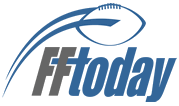




 Outside of his magical 2007 season when he threw for nearly 5,000 yards and 50 touchdowns, Brady was never better than he was in 2010. Despite losing the team’s projected top receiver and only true deep threat, Randy Moss, in an early-season trade and being left with a group of merely average receivers, Brady threw for 3,900 yards and 36 touchdowns with a career-low four interceptions. He easily adapted to Moss’ departure, with the offense moving from an air-it-out to more of a dink-and-dunk approach. Considering what he accomplished last year with a lackluster receiving corps, Brady is essentially a guarantee to produce at quarterback. With talented tight ends Rob Gronkowski and Aaron Hernandez entering their second seasons and with the team hopeful that either Brandon Tate or
Outside of his magical 2007 season when he threw for nearly 5,000 yards and 50 touchdowns, Brady was never better than he was in 2010. Despite losing the team’s projected top receiver and only true deep threat, Randy Moss, in an early-season trade and being left with a group of merely average receivers, Brady threw for 3,900 yards and 36 touchdowns with a career-low four interceptions. He easily adapted to Moss’ departure, with the offense moving from an air-it-out to more of a dink-and-dunk approach. Considering what he accomplished last year with a lackluster receiving corps, Brady is essentially a guarantee to produce at quarterback. With talented tight ends Rob Gronkowski and Aaron Hernandez entering their second seasons and with the team hopeful that either Brandon Tate or 
 Henne’s fantasy stock was on the rise entering 2010 after the Dolphins traded for Broncos wide receiver Brandon Marshall. The acquisition of Marshall provided Henne with a true number one wide receiver for the first time. With another year under his belt, a solid running game, and Marshall opening up defenses, Henne seemed like a sound bet to have a productive season under center for Miami. Unfortunately for Henne’s owners, he failed to take advantage of the situation and had a disappointing season, throwing for just 3,301 yards with 15 touchdowns and 19 interceptions. He enters 2011 knowing it is a pivotal year in his career. The 2008 second-round pick’s contract is up after the season and he knows this will be his last chance to solidify the starting position in Miami. While he will be motivated, we don’t like his chances of having a breakout season. Henne’s prospects of developing into a fantasy starter are slim, and he fits in as a low-end fantasy backup with little upside.
Henne’s fantasy stock was on the rise entering 2010 after the Dolphins traded for Broncos wide receiver Brandon Marshall. The acquisition of Marshall provided Henne with a true number one wide receiver for the first time. With another year under his belt, a solid running game, and Marshall opening up defenses, Henne seemed like a sound bet to have a productive season under center for Miami. Unfortunately for Henne’s owners, he failed to take advantage of the situation and had a disappointing season, throwing for just 3,301 yards with 15 touchdowns and 19 interceptions. He enters 2011 knowing it is a pivotal year in his career. The 2008 second-round pick’s contract is up after the season and he knows this will be his last chance to solidify the starting position in Miami. While he will be motivated, we don’t like his chances of having a breakout season. Henne’s prospects of developing into a fantasy starter are slim, and he fits in as a low-end fantasy backup with little upside.

